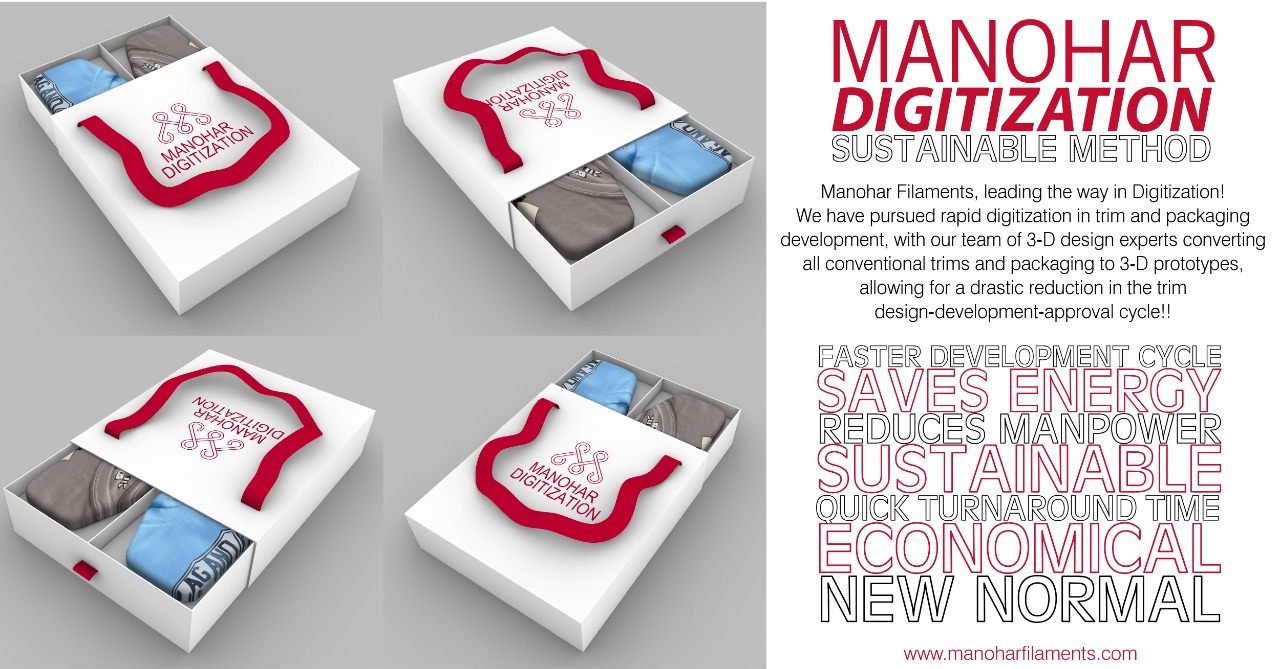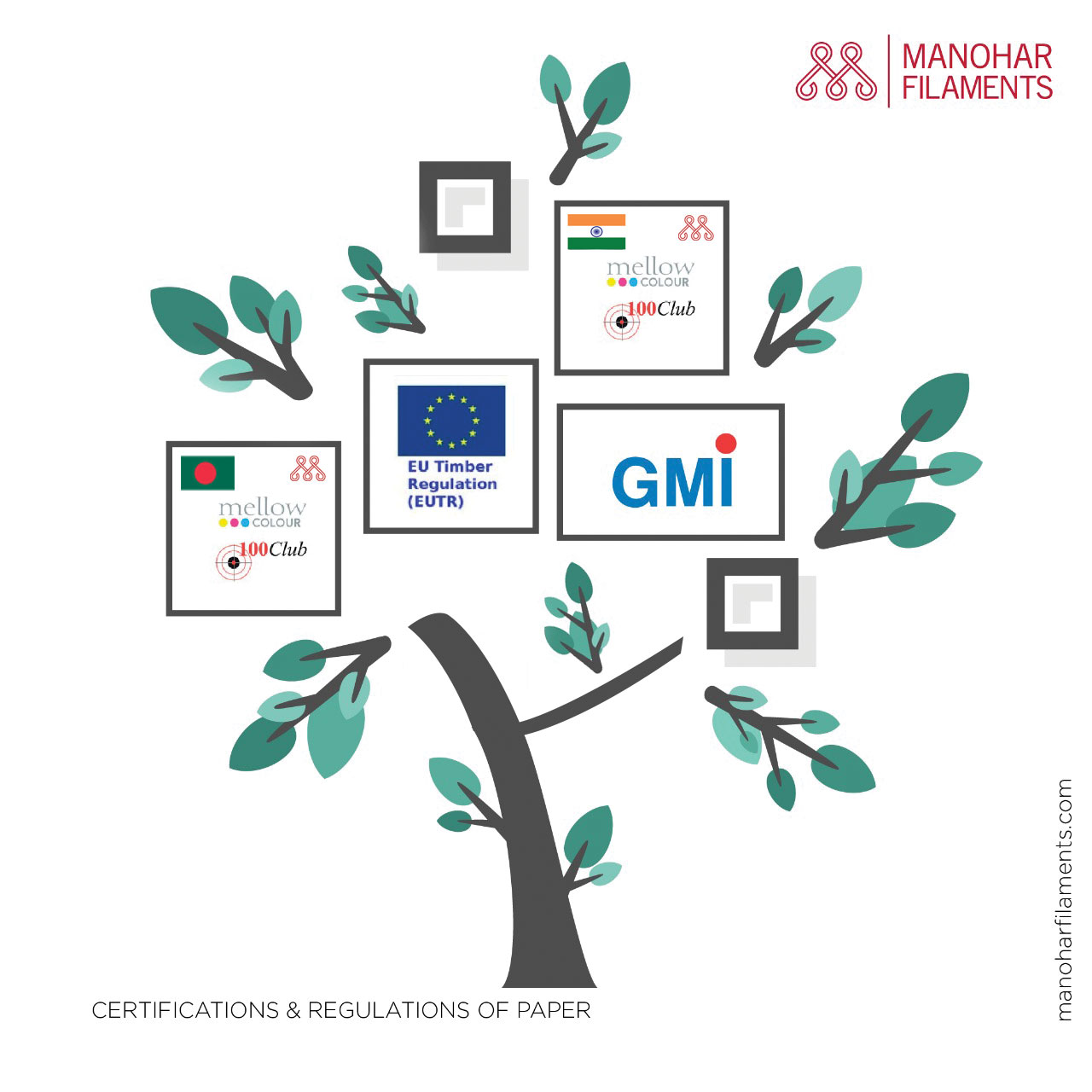Q&A Session with Mrs. Rashmi Sharma (Head IT) and Mrs. Rupali Jain (Head Creative & Development)
Q- Mrs. Rashmi, what is Manohar Filaments doing in terms of digitization and how does it help your end customer?
Rashmi- Well, Manohar filaments as a company is committed to pursuing digitization across the board, both in operations and our extended value chain. Internally we have been working on connecting our plants through a single IT application M plus, this was initiated way before the pandemic, it is a system which creates a uniform work-flow across manufacturing locations, thereby allowing for impeccable traceability and strong process orchestration.
However, what we are really excited about is our newly developed ability to convert sample development process from a completely physical process to a fully digital one. We have developed a mechanism which allows us to create high quality 3-D models of products which would otherwise need to be physically sampled and this allows us to drastically reduce the product development cycle time and makes the approval process a lot easier for our customers.
Q- Mrs. Rupali, could elaborate a bit more on what you are doing to digitize the Trim sampling process and does this imply that physical samples will no longer be created/required?
Rupali- Physical samples are needed in a garment/apparel development process, but through digitization, the whole activity can be made more efficient, let me explain how. Initially what we recommend for any buyer testing the digitization waters, is to tread lightly and do a phased digital adoption.
The phases are quite simple, first we recommend that based on specs and art-files shared, we create samples and instead of us submitting the samples and then the samples making the journey across the world, we share 3-D models/renders of the actual product, which can be viewed and photographed/scanned in such a manner that the output is perfectly presented for speedy approval. In the second phase, we digitize the samples entirely, sharing high definition and fully digital models, with samples submitted to the brand only if required, else we can proceed with bulk based on approvals of 3-D models, finally in phase 3 we recommend complete digitization of the product development process, where sample files are shared and approved based on 3-D models created by our design teams and garment vendors then order trims needed based on the digital approvals received, in this stage, integration of the 3-D process and our bespoke order management system happens, where trims are updated from design to physical form, without any member of the value chain having to physically ship or handle samples, rather deal only with bulk production.
Q- Mrs. Rashmi, does this digitization have an impact cost aspect aside from making sampling efficient?
Rashmi- Yes, making any process more efficient does reflect that there would be a cost benefit, however, digitization of the sample process is a triple whammy, it reduces costs related to sampling drastically, reduced time needed for approvals immensely and finally it is an extremely sustainable way to operate.
Costs, typically a trim sample might cost anywhere between 50-100 USD to develop just in terms of material and machine time, then add to it packaging, shipping and subsequent shipping back after approvals, none of these costs are encountered when the process is digital and the cost of sample development reduces too if the only sample being reviewed and approved is a 3-D, digital render. Now imagine hundreds of samples being digitized the monetary savings thus incurred would be substantial, which can then be passed on to the ultimate customer.
Time, the whole sample development process takes at least 2 weeks to sometimes even 8-10 weeks depending on what kind of item is being developed and raw material availability. When the sample development process is digitized, all this time can be diverted to creation of bulk, which means a sample might be developed virtually, applied on a garment to see whether or not it works, changes made and final approvals given for bulk in less than 48 hours, this is major reduction in sample development cycle time, which would allow brands to become more resilient to demand pattern changes and become agile to make changes late in their own design process and still be able to meet their collection and retail deadlines.
Sustainable- When we reduce the amount of material consumed in sampling and re-sampling, in sending samples back and forth by air across the globe, it has a direct impact on the way in which we affect our environment. The less material used, the lower the need to send samples and waste precious fuel, the more sustainable the whole process becomes. We strongly recommend to all our partners to adopt in some way shape or form digitization as Rupali suggested, it is not necessary to move from a completely analogue process to a completely digital one, but it can be along a continuum and as results are improving, digitization may be expedited.
Q- Final question to Mrs. Rupali, do you think digital will fully replace actual samples and what is the future of digitization?
Rupali- Well, as I stated earlier, actual physical samples of trims are essential and they might never be fully replaced by their digital counterparts. What can certainly happen and should is that trims which are either generic in nature or do not involve extremely high level of workmanship, complexity or detail can be digitized right of the bat and unless their designs or specifications are changed they may be kept digital. For other more complicated trims, I recommend development and then digitization, which would still reduce cycle time and costs, time is saved as transit is eliminated and costs associated with the same too reduced.
Each and every company which develops and retails apparels is unique and has a unique market position, thereby their strategies and stages of digitization differ from one another, for example a premium brand which sells extremely intricate high fashion merchandise while wanting to fully digitize might still keep some aspects of sample development process old-school, whereas a fast fashion low value and high volume retailer might digitize the trim sample development completely. What is important to understand here, is the fact that Manohar Filaments is ready to collaborate with all brands and buyers on their digitization journey and can offer tailor made and customized solution which fit their needs best.
The future however is digital and we will definitely see a major shift in the way trims are developed and supplied by end 2021 and early 2022, with more and more brands going digital. Finally, we wish all Women leaders in the industry a very Happy Women’s Day and wish to see more women leaders in the world as is the case in our company! Cheers!

Q&A Session with Mrs. Rashmi Sharma (Head IT) and Mrs....

Question- Mr. Amit, how do you think the Apparel industry...

Mr. Manish, good to have you answer few of our...

Interviewer- What do you think sets Manohar Filaments Apart from...